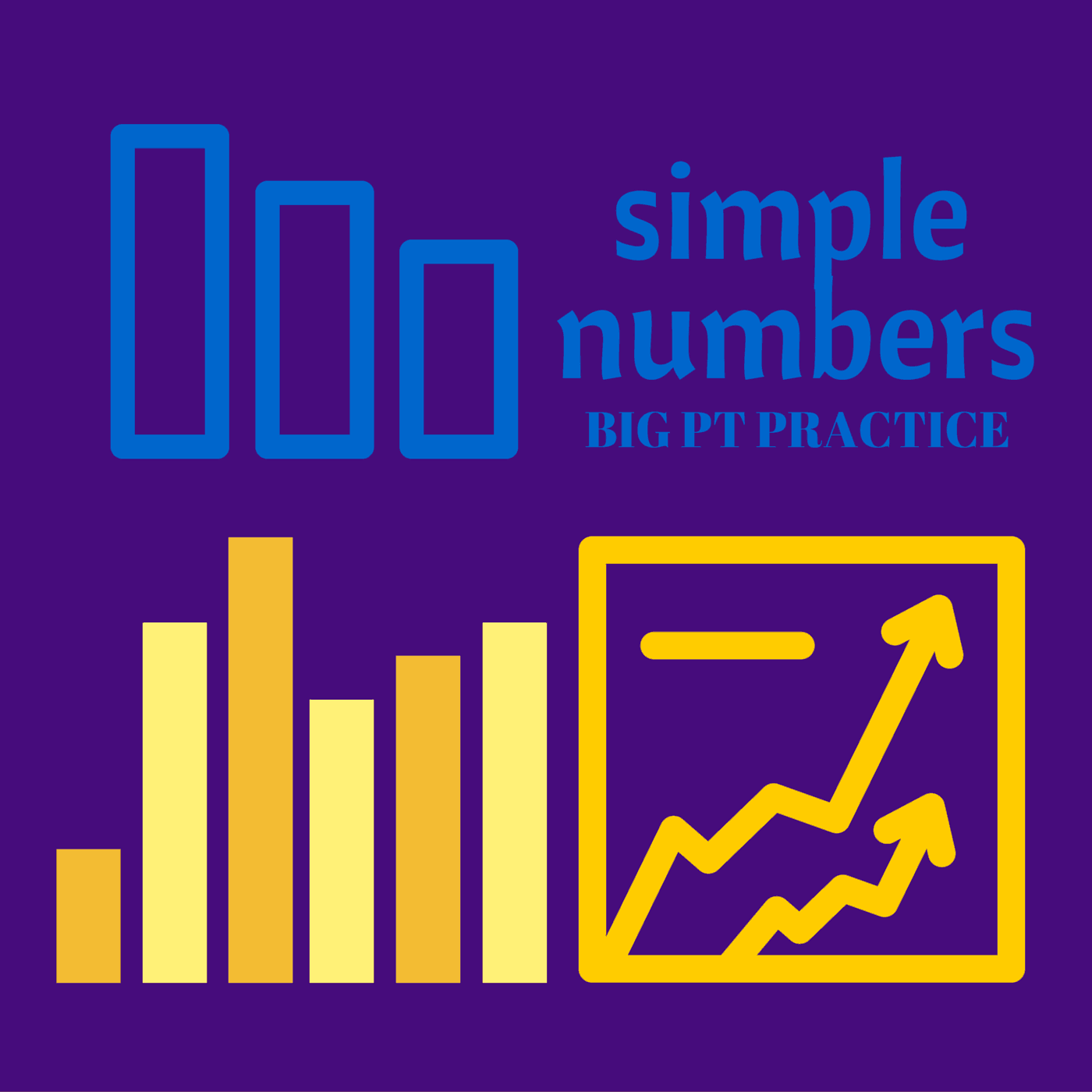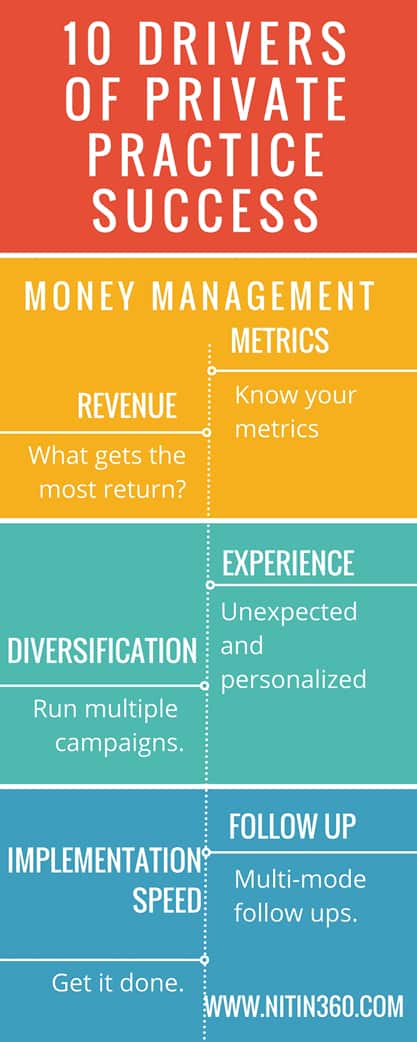To grow a physical therapy business practice, it’s important to be in continuous marketing mode.
Marketing is the engine that drives your practice.
In any given week, the number of initial evaluations should meet or exceed the number of discharged patients. That is, if you want to grow your practice. Understandably, this can be a challenge. This is not your fault since it’s not something you are taught in physical therapy school.

This means that you’ve got to be in constant marketing mode. You can’t take your foot ‘off the gas’. You’ve got to plan ahead with your practice. In fact, you should have a monthly marketing plan in place for your physical therapy business practice (something that I do for Mastermind and Referral Ignition Elite clients).
The only way to be in constant marketing mode is with the right systems (like the Referral Ignition systems) and the right people (I created a detailed training program called Hiring Rx, where you’ll discover how to identify, attract, hire and motivate staff members).
Planning your marketing will allow you to:
- Increase income
- Prepare to bring on additional therapists.
- Build your expert status with patients and physicians
- Reduce stress and eliminate the frustrations of ‘slumps’ in referrals
As the clinician and the billing provider, you are constantly treating, documenting and billing. It’s easy to get lost in day-to-day stuff and lose sight of the big picture, the reason why you are in practice to begin with.
If you take a step back and look at the forest through the trees, you’ll realize something profound.
Let me prove it with a simple numbers test. This test let you know if your practice is growing (or declining).
To use this text, you’ll need four pieces of information, what I like to call ‘practice metrics’:
- The number of patient visits you complete each week.
- Your average reimbursement per visit.
- Your average expenses each week (rent, utilities, staff and miscellaneous expenses).
- Your income goal as a practice owner.
Based on your income goals, you can actually reverse engineer your success. With simple numbers, you can pave the way for big success.
I’ll use a couple of scenarios to explain this better.
SCENARIO ONE
A practice has one physical therapist, and all the revenue in the practice is generated by that physical therapist. This ‘primary physical therapist’ is also the owner, and has an income goal of $300,000 a year.
Let’s say the primary physical therapist:
- Completes 60 patient visits a week
- Gets reimbursed $80 per patient visit
- Brings in $4800 in weekly revenue
 Hopefully, you’ve noticed the fact that we have identified all four of the key practice metrics here.
Hopefully, you’ve noticed the fact that we have identified all four of the key practice metrics here.
- In this situation, let’s say the weekly expenses (including rent, utilities and payroll of staff including the front desk salary) are $2000.
- The net profit of the clinic (total income minus total expenses) is about $2800.
Keep in mind that it’s possible to dig into this and get really microscopic, but let’s remain at a very high level here for the purpose of this article.
Even though the net profit is $2800, the income goal of the practice owner (which is $6000 a week) has not been met, which is equal to $310,000 a year (52 weeks in a year multiplied by weekly income $6000 helps estimate annual income).
For this example, I’m assuming that the corporate structure is a limited liability company (LLC). With an LLC, the profit of the business becomes the income of the owner. If you have another corporate structure, it’s best to seek the advice of an accountant or certified tax professional.
This is how a one provider private practice looks like.
SCENARIO TWO
Now, let’s say that ONE additional provider is added to the clinic.
Keep in mind scenario one (net profit of $2800) continues and the practice starts to grow. This creates the need to hire an additional therapist.
If an additional therapist was brought into the clinic, and he / she also had the same productivity, then that secondary physical therapist also:
- Completes 60 patient visits a week
- Gets reimbursed $80 per patient visit
- Brings in $4800 in weekly revenue
If you are not sure when the right time to bring on another physical therapist is, look at this article on “When is the best time to hire an additional therapist?”
Now, let’s assume that the salary of this full time physical therapist is $40 an hour including benefits, you are looking at $1600 a week in expenses.
The rest of your expenses don’t go up. They stay the same and have already been taken into consideration in scenario one.
The net profit for the clinic from this secondary provider (total income minus new expenses which include the salary of this physical therapist) is about $3200.
The combined income from the primary ($2800) and the secondary ($3200) is now $6000 a week. This is $310,000 a year in net revenue for the practice.
In this scenario, a one-man private practice owner can achieve financial independence by adding just one more provider to the practice. There is a simple, but powerful lesson here.
As you add more providers, a significant portion of the revenue generated by them drops straight to the bottom line of the practice. With the first provider, on the other hand, a large portion of the income is used to cover costs like rent, utilities, payroll and miscellaneous costs. Therefore, in general, hiring more staff results in higher profitability for a physical therapy business practice.
The only way you can identify where you are, and where you need to be, is by identifying and tracking your own ‘practice metrics’. Here they are again:
- The number of patient visits you complete each week.
- Your average reimbursement per visit.
- Your average expenses each week (rent, utilities, staff and miscellaneous expenses).
- Your income goal as a practice owner.
… just as blood pressure, pulse rate and cholesterol levels are important to an individual with history of heart disease.
Don’t ignore it. It could be the difference between a practice that’s struggling and one that’s ready to serve patients and continue to grow and become highly profitable.
Building a practice is indeed a numbers game, when you look at the forest through the trees.






